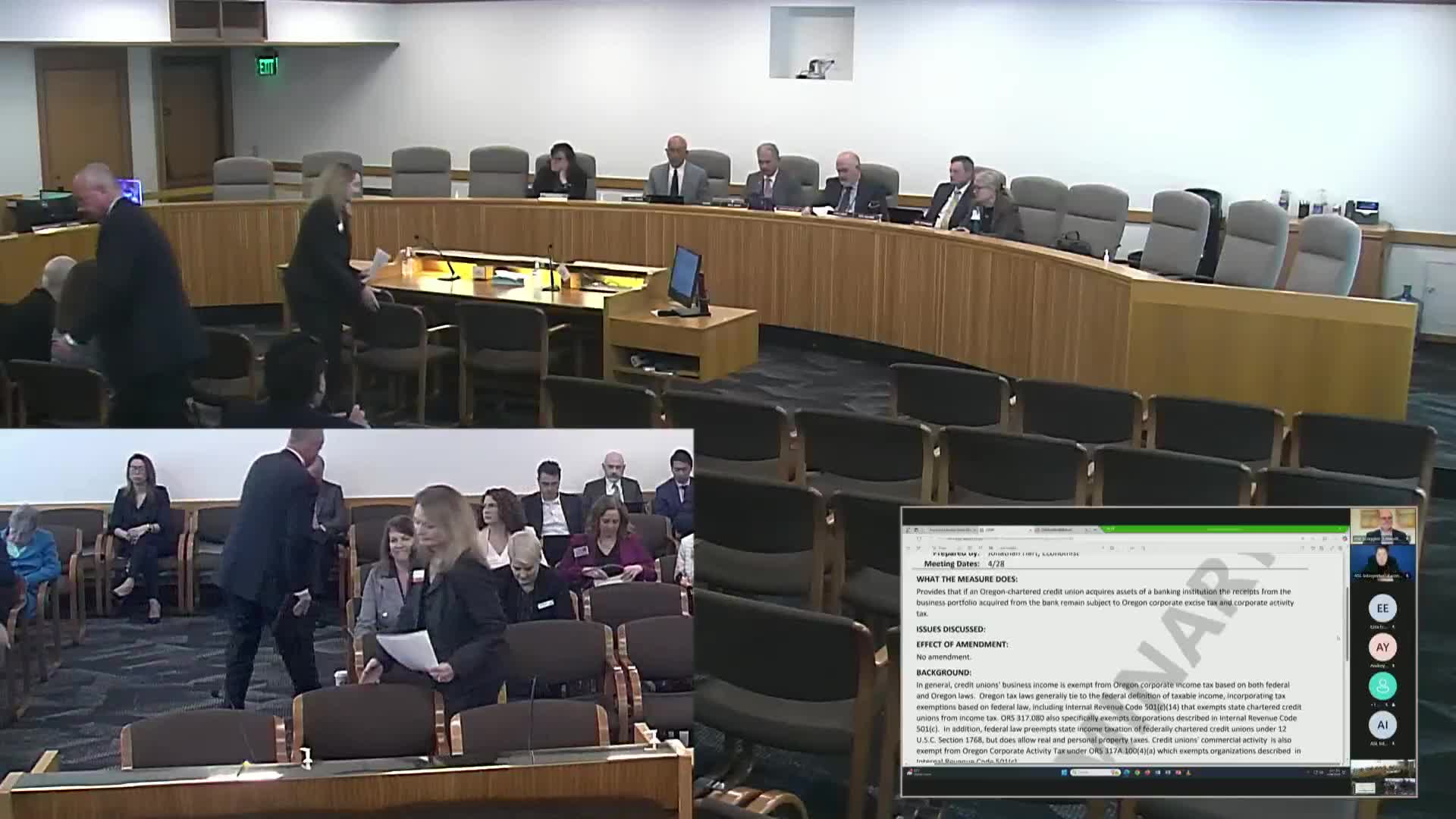Legislative staff explains proposal to raise disabled‑veteran property tax exemptions and adds means test questions
April 28, 2025 | Finance and Revenue, Senate, Committees, Legislative, Oregon
This article was created by AI summarizing key points discussed. AI makes mistakes, so for full details and context, please refer to the video of the full meeting. Please report any errors so we can fix them. Report an error »

On April 28, 2025, the Senate Committee on Finance and Revenue received an informational briefing on Senate Bill 387, which would increase several property tax exemption amounts for disabled veterans and surviving spouses and add two new partial exemptions.
Beau Olin of the Legislative Revenue Office presented the bill’s structure, described the exemption amounts (listed in section 1 of the bill) and outlined several technical and implementation questions staff flagged for the committee. The briefing emphasized that the bill increases current assessed‑value exemption amounts and also introduces a new means test tied to taxable income.
Olin summarized key provisions: existing exemptions that currently rise roughly 3% per year would be set to fixed higher amounts (for example, increases from about $25,000 to $60,000 for certain exemptions and from about $31,000 to $65,000 for another). The bill would add a new exemption of $150,000 (assessed value) and a second new partial exemption set at 90% of assessed value; those new amounts would also grow at 3% annually under the draft language.
Staff noted a distinct means‑test provision in section 1(7) that refers to "taxable income up to $120,000 for separate returns or $240,000 for joint returns." Olin warned that the draft does not specify whether "taxable income" refers to federal or Oregon taxable income and that the means test could affect who qualifies. He also said the bill references U.S. Department of Veterans Affairs criteria for individual unemployability in one exemption and that the text might be clarified to specify the intended standard.
On preliminary fiscal impacts, Olin said the analysis assumes the two new partial exemptions would be funded by a state general‑fund appropriation and estimated total property‑tax reductions for qualifying disabled veterans and surviving spouses of about $80–$90 million per biennium. He said the distribution of that reduction is roughly one‑third local and two‑thirds state under the assumption of a state appropriation to cover the new partial exemptions.
Olin also raised practical implementation questions: whether county assessors would need access to taxpayers’ income tax returns to certify eligibility, and whether additional confidentiality guardrails would be required. He said about 40,000 people currently participate in the exemption program and that the bill’s means test could disqualify some current participants while enabling other residents to newly qualify depending on the interaction of changes.
Senator Taylor asked for comparative information about how neighboring states treat disabled‑veteran property tax exemptions; Olin said staff could provide that research in a follow‑up. The briefing closed with committee members thanking staff and saying further work could follow if members want to move the bill.
Beau Olin of the Legislative Revenue Office presented the bill’s structure, described the exemption amounts (listed in section 1 of the bill) and outlined several technical and implementation questions staff flagged for the committee. The briefing emphasized that the bill increases current assessed‑value exemption amounts and also introduces a new means test tied to taxable income.
Olin summarized key provisions: existing exemptions that currently rise roughly 3% per year would be set to fixed higher amounts (for example, increases from about $25,000 to $60,000 for certain exemptions and from about $31,000 to $65,000 for another). The bill would add a new exemption of $150,000 (assessed value) and a second new partial exemption set at 90% of assessed value; those new amounts would also grow at 3% annually under the draft language.
Staff noted a distinct means‑test provision in section 1(7) that refers to "taxable income up to $120,000 for separate returns or $240,000 for joint returns." Olin warned that the draft does not specify whether "taxable income" refers to federal or Oregon taxable income and that the means test could affect who qualifies. He also said the bill references U.S. Department of Veterans Affairs criteria for individual unemployability in one exemption and that the text might be clarified to specify the intended standard.
On preliminary fiscal impacts, Olin said the analysis assumes the two new partial exemptions would be funded by a state general‑fund appropriation and estimated total property‑tax reductions for qualifying disabled veterans and surviving spouses of about $80–$90 million per biennium. He said the distribution of that reduction is roughly one‑third local and two‑thirds state under the assumption of a state appropriation to cover the new partial exemptions.
Olin also raised practical implementation questions: whether county assessors would need access to taxpayers’ income tax returns to certify eligibility, and whether additional confidentiality guardrails would be required. He said about 40,000 people currently participate in the exemption program and that the bill’s means test could disqualify some current participants while enabling other residents to newly qualify depending on the interaction of changes.
Senator Taylor asked for comparative information about how neighboring states treat disabled‑veteran property tax exemptions; Olin said staff could provide that research in a follow‑up. The briefing closed with committee members thanking staff and saying further work could follow if members want to move the bill.
View full meeting
This article is based on a recent meeting—watch the full video and explore the complete transcript for deeper insights into the discussion.
View full meeting
